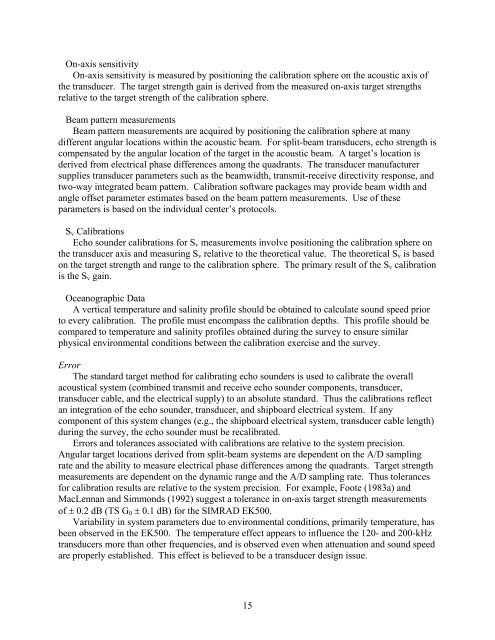NOAA Protocols for Fisheries Acoustics Surveys and Related ...
NOAA Protocols for Fisheries Acoustics Surveys and Related ...
NOAA Protocols for Fisheries Acoustics Surveys and Related ...
You also want an ePaper? Increase the reach of your titles
YUMPU automatically turns print PDFs into web optimized ePapers that Google loves.
On-axis sensitivity<br />
On-axis sensitivity is measured by positioning the calibration sphere on the acoustic axis of<br />
the transducer. The target strength gain is derived from the measured on-axis target strengths<br />
relative to the target strength of the calibration sphere.<br />
Beam pattern measurements<br />
Beam pattern measurements are acquired by positioning the calibration sphere at many<br />
different angular locations within the acoustic beam. For split-beam transducers, echo strength is<br />
compensated by the angular location of the target in the acoustic beam. A target’s location is<br />
derived from electrical phase differences among the quadrants. The transducer manufacturer<br />
supplies transducer parameters such as the beamwidth, transmit-receive directivity response, <strong>and</strong><br />
two-way integrated beam pattern. Calibration software packages may provide beam width <strong>and</strong><br />
angle offset parameter estimates based on the beam pattern measurements. Use of these<br />
parameters is based on the individual center’s protocols.<br />
S v Calibrations<br />
Echo sounder calibrations <strong>for</strong> S v measurements involve positioning the calibration sphere on<br />
the transducer axis <strong>and</strong> measuring S v relative to the theoretical value. The theoretical S v is based<br />
on the target strength <strong>and</strong> range to the calibration sphere. The primary result of the S v calibration<br />
is the S v gain.<br />
Oceanographic Data<br />
A vertical temperature <strong>and</strong> salinity profile should be obtained to calculate sound speed prior<br />
to every calibration. The profile must encompass the calibration depths. This profile should be<br />
compared to temperature <strong>and</strong> salinity profiles obtained during the survey to ensure similar<br />
physical environmental conditions between the calibration exercise <strong>and</strong> the survey.<br />
Error<br />
The st<strong>and</strong>ard target method <strong>for</strong> calibrating echo sounders is used to calibrate the overall<br />
acoustical system (combined transmit <strong>and</strong> receive echo sounder components, transducer,<br />
transducer cable, <strong>and</strong> the electrical supply) to an absolute st<strong>and</strong>ard. Thus the calibrations reflect<br />
an integration of the echo sounder, transducer, <strong>and</strong> shipboard electrical system. If any<br />
component of this system changes (e.g., the shipboard electrical system, transducer cable length)<br />
during the survey, the echo sounder must be recalibrated.<br />
Errors <strong>and</strong> tolerances associated with calibrations are relative to the system precision.<br />
Angular target locations derived from split-beam systems are dependent on the A/D sampling<br />
rate <strong>and</strong> the ability to measure electrical phase differences among the quadrants. Target strength<br />
measurements are dependent on the dynamic range <strong>and</strong> the A/D sampling rate. Thus tolerances<br />
<strong>for</strong> calibration results are relative to the system precision. For example, Foote (1983a) <strong>and</strong><br />
MacLennan <strong>and</strong> Simmonds (1992) suggest a tolerance in on-axis target strength measurements<br />
of ± 0.2 dB (TS G 0 ± 0.1 dB) <strong>for</strong> the SIMRAD EK500.<br />
Variability in system parameters due to environmental conditions, primarily temperature, has<br />
been observed in the EK500. The temperature effect appears to influence the 120- <strong>and</strong> 200-kHz<br />
transducers more than other frequencies, <strong>and</strong> is observed even when attenuation <strong>and</strong> sound speed<br />
are properly established. This effect is believed to be a transducer design issue.<br />
15
















